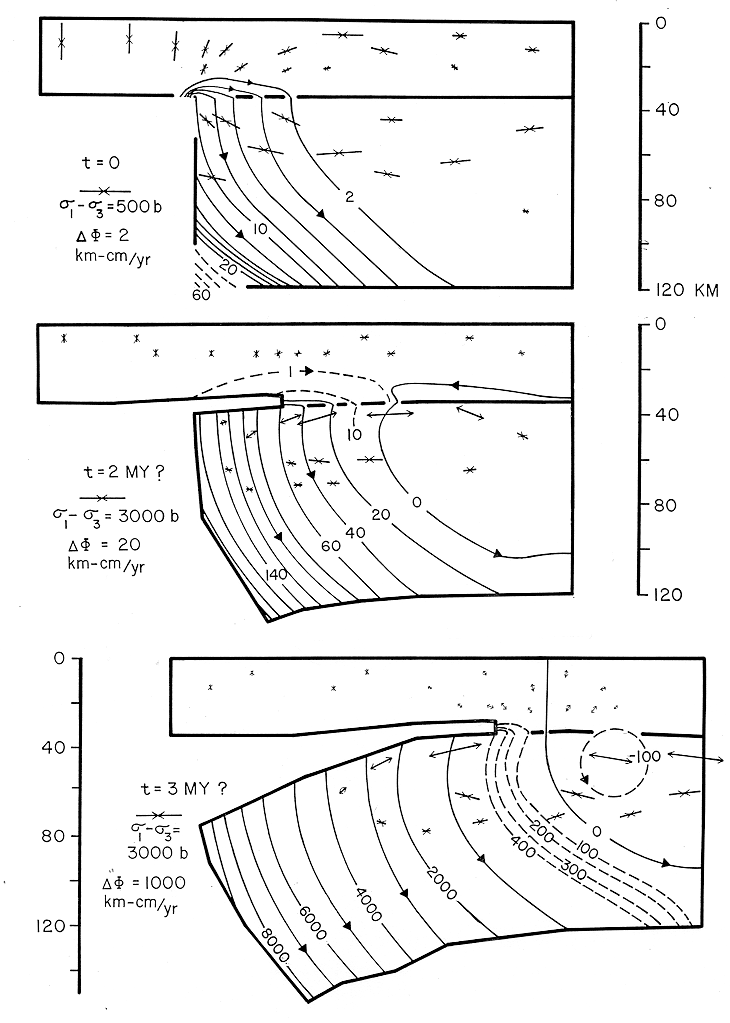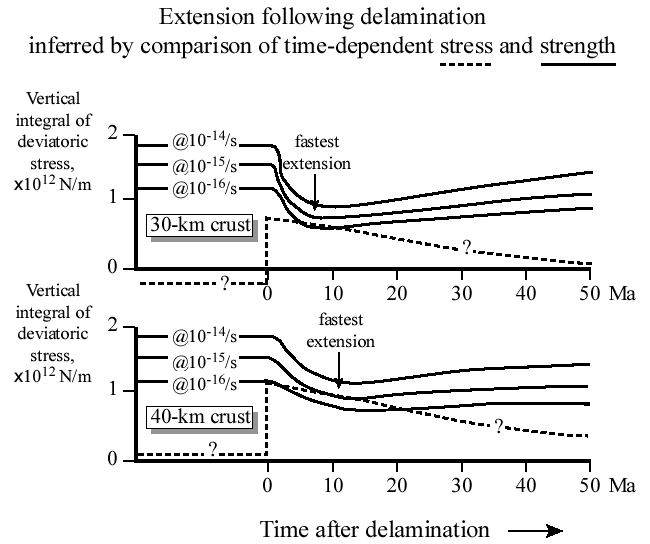11. Bird, P. (1979) Continental delamination and the Colorado Plateau, J. Geophys. Res., 84, 7561-7571.
Abstract. Continental lithosphere is in unstable mechanical equilibrium because its mantle layer is denser than the asthenosphere. If any process such as cracking, slumping, or plume erosion initially provided an elongated conduit connecting the underlying asthenosphere with the base of the continental crust, the dense lithospheric boundary layer could peel away from the crust and sink. An analytic model for sinking velocities at the critical initial time shows that instability occurs if the effective viscosities of the lower continental crust and the rising asthenosphere are no more than 1019 P. Analogies to subduction suggest that the mature instability would grow laterally at plate tectonic velocities; however, it would be almost aseismic. Loss of the cold mantle boundary layer would cause uplift, increased heat flow, reduced seismic velocities, and perhaps emplacement of basalt flows, mantle diatremes, and granodiorite sills. A one-dimensional thermal model of the formation of a new boundary layer predicts a half life of about 3 ´ 107 years for this thermal anomaly and uplift. As an example, the geologic and geophysical data from the Colorado Plateau are shown to be consistent with the hypothesis that it was uplifted by a delamination event 30 m.y. ago and perhaps a second event about 5 m.y. ago.
P.S. (1) The theory of delamination presented here is sound, but the example may be unfortunate. When I wrote this, I assumed that the Colorado Plateau was not affected by subduction, but that was before I learned about horizontal subduction from Bill Dickinson. Now, I think that the Colorado Plateau lithosphere "didn't fall off; it was pushed!" That is, Colorado Plateau mantle lithosphere may have been sheared away by horizontally-subducting oceanic-plate lithosphere, which then dropped away at ~30 Ma, in a process rather different from delamination. See my publications #18, 20, 26 and 45. (2) The second delamination/uplift event that I inferred for the Colorado Plateau (at ~5 Ma) rested on 3 bits of evidence: (a) post-depositional uplift of the Bouse Formation from sealevel; (b) Hopi Buttes diatreme suite; (c) shift of Colorado River and cutting of Grand Canyon. Now, the Bouse Formation has been reinterpreted as non-marine by Poulson & John [2003], which invalidates argument (a). As far as I know, however, events (b) and (c) still need explanations. (3) Poise is not a SI unit. Convert 1019 P = 1018 Pa s. P. Bird, 2003.04.11
P.P.S.
Delamination may be underway beneath the central Sierra Nevada of California;
see H. Gilbert, C. Jones, T. J. Owens, and G. Zandt [2007] Imaging
Sierra Nevada lithosphere sinking, Eos Trans. AGU, 88(21), 22 May 2007,
p. 225-229. P. Bird, 2007.06.04
For modern seismic evidence supporting this model (and reviewing a large
literature about it), see Schulte-Pelkum & Kilb [2024, Geophysical
Research Letters]. P. Bird, 2025.02.03
P.P.P.S. At the April 2019 meeting of the European Geosciences Union, Dr. João C. Duarte of the University of Lisbon reported a model in which delamination is underway under the Horseshoe abyssal plain. Associated seismicity may include the m7.8 Portugal earthquake of 1969 (if that was not due to plate-boundary seismicity), and also microseismicity within a high-velocity mantle anomaly extending down to 250 km depth. The critical plane of weakness in the lithosphere could be a serpentinized layer. P. Bird, 2019.05.10
PDF of paper
N.B. This PDF is posted here because the online AGU archive of old JGR
issues does not include Number B13 of Volume 84 of 1979 (and this problem has
persisted for years).
P. Bird 2011.03.01
Ý Delamination cannot begin until some process breaks through the mantle lithosphere, allowing asthenosphere to contact the crust. Here are 4 possible causes of delamination: convective instability, rifting, plume erosion, or continental collision.
Ý At the beginning of delamination, an analytic solution is possible (box), relating the rate of lithosphere sinking Vz to the viscosity and thickness of the lower crust, and the thickness and viscosity of the mantle lithosphere.
Ý These 3 steps from a finite-element simulation of accelerating delamination were obtained by neglecting viscous resistance in the asthenosphere. Note the changes in the contour intervals for the stream function. By the third step, the subsiding lithosphere has reached velocities of 1 m/year, at which point it is no longer reasonable to make this approximation.
Ý If we adopt a moving reference frame, we can see that the asthenospheric flow around a mature delamination front is similar to that around a subducting slab of oceanic lithosphere, especially if the subduction system includes back-arc spreading. Based on this analogy, we might expect mature delamination events to propagate laterally at 10-20 cm/year.
Ý Calculated thermal history (based on one-dimensional heat conduction) following instantaneous delamination at time t = 0 Ma. A new mantle lithosphere is gradually formed by cooling of asthenosphere.
Ý Predicted histories of heat flow, elevation, and gravity anomaly following instantaneous delamination at time t = 0 Ma. Based on the one-dimensional thermal model presented above.
Ý Theoretical prediction of possible extensional strain in the delaminated region, peaking about 10 Ma after delamination. Although the extensional stress is greatest immediately after delamination, the strength minimum coincides with the heat-flow maximum that comes somewhat later. Addition or subtraction of regional horizontal stress could move the dashed stress-history curves up or down, changing the rate of extension. However, this would have little effect on the timing of extension.






